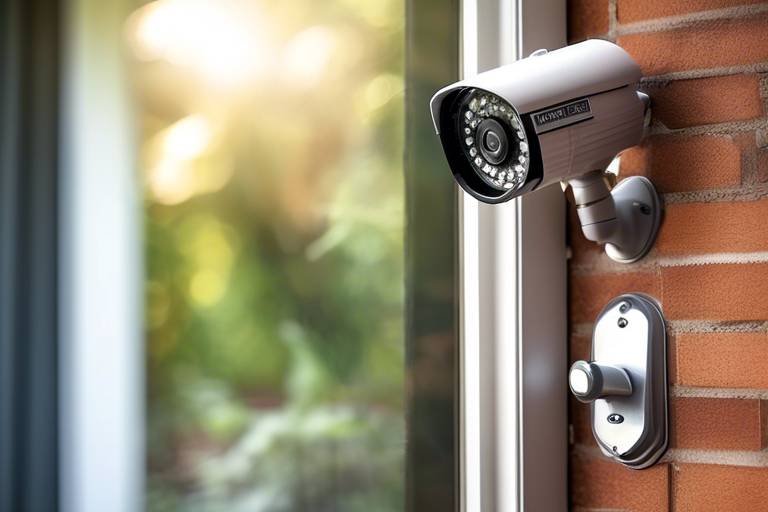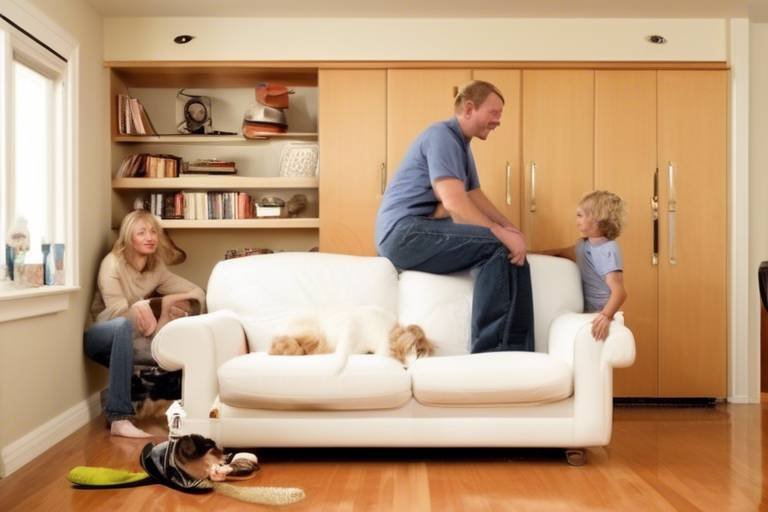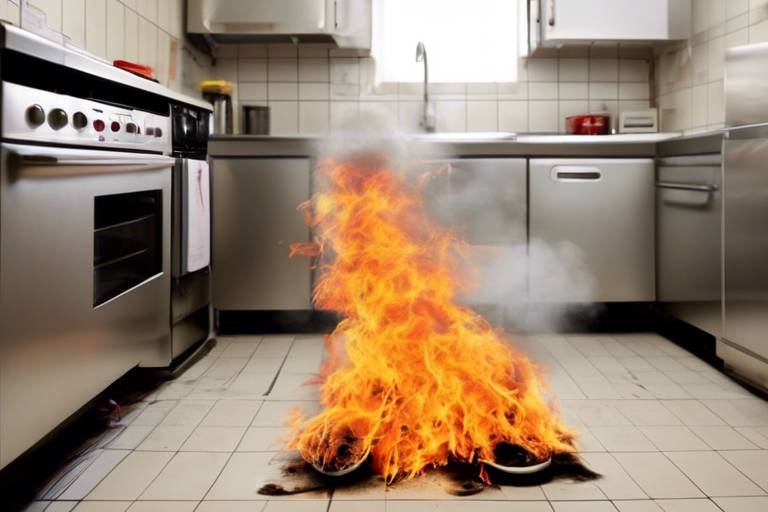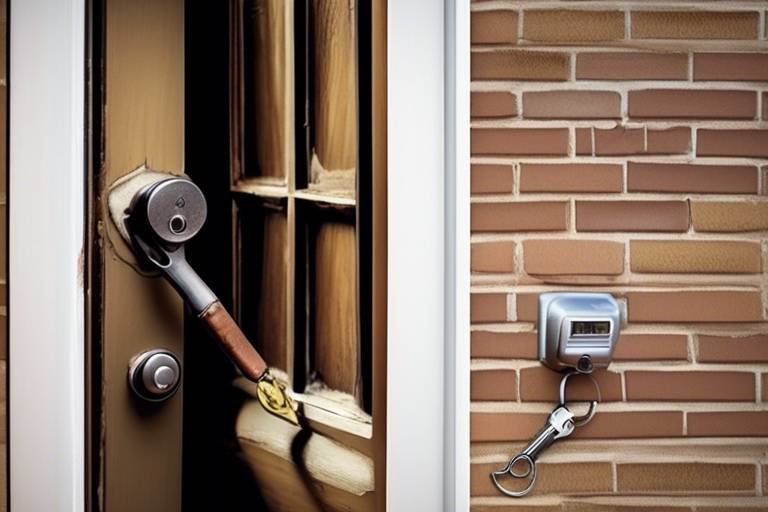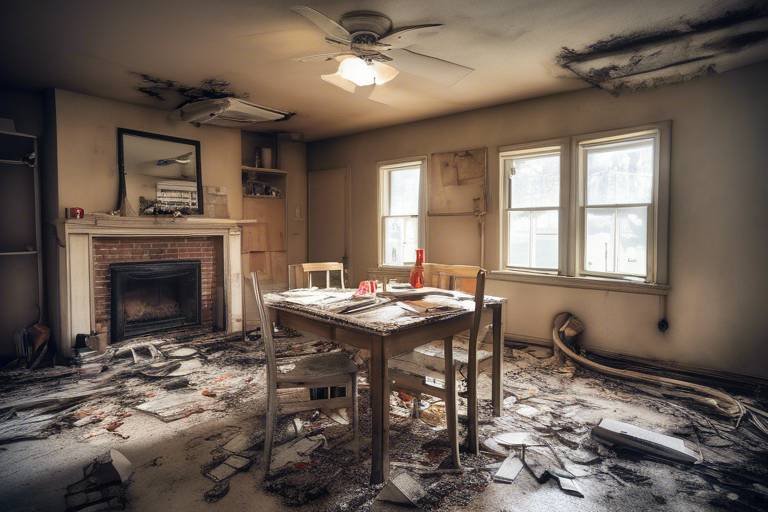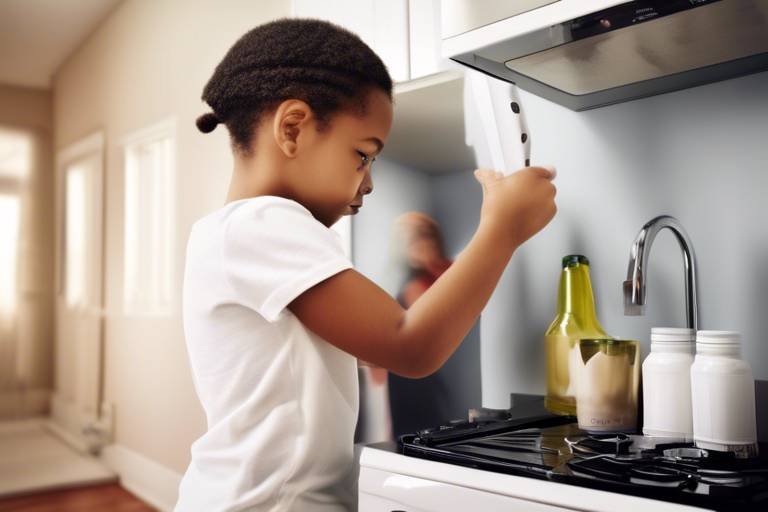Safety Hazards in Old Homes - What to Look For
Owning an older home can be a dream come true for many, with their unique charm and character. However, lurking beneath that quaint facade are potential safety hazards that can turn your dream into a nightmare. It's essential to be aware of these dangers, not just for your peace of mind but for the safety of everyone who lives in or visits your home. This article dives into the common safety hazards found in older homes, shedding light on what to look for and how to address these issues effectively.
One of the first things to consider in an older home is its structural integrity. Over the years, homes can experience a variety of issues, from sagging roofs to weakened foundations. Imagine your home as a house of cards; if one card is out of place, the entire structure is at risk. Signs of structural problems may include cracks in the walls, uneven floors, or doors that don’t close properly. If you notice any of these red flags, it’s crucial to consult a professional. Addressing structural issues early on can save you from costly repairs down the line.
Now let’s talk about something that can literally be shocking—your home’s electrical system. Many older homes are equipped with outdated wiring that can pose significant risks, such as fire hazards and electrical shocks. If your home still has knob-and-tube wiring or if the electrical panel is outdated, you might want to consider an upgrade. Flickering lights, frequently tripped circuit breakers, and outlets that feel warm to the touch are all signs that your electrical system needs attention. Remember, safety first!
Next up on our safety checklist is plumbing. Aging pipes can lead to leaks, water damage, and even mold growth. Think of your plumbing as the veins of your home; if they’re clogged or damaged, everything else suffers. Look for signs of water stains on ceilings or walls, damp spots on floors, or a sudden increase in your water bill. These may be indicators of hidden plumbing problems. Addressing these issues promptly can prevent severe complications and keep your home safe and dry.
If your home was built before the 1980s, there’s a chance it may contain hazardous materials like asbestos and lead paint. Asbestos was commonly used in insulation and flooring, while lead paint was prevalent in homes before it was banned in 1978. Disturbing these materials during renovations can release harmful particles into the air, posing serious health risks. If you suspect your home contains these substances, it’s crucial to hire professionals for safe removal and remediation.
Old heating and cooling systems can be a double whammy: not only can they be inefficient, but they can also be unsafe. If your home still relies on an old furnace or an outdated air conditioning unit, it might be time for an upgrade. Look out for signs like uneven heating, strange noises, or an increase in your utility bills. Upgrading to modern, energy-efficient systems not only ensures your comfort but also enhances safety.
Older homes often lack modern fire safety features, which can increase the risk of fire. Check for smoke detectors, fire extinguishers, and escape routes. If your home doesn’t have these essential safety measures, it’s time to implement them. A simple checklist can help you assess your fire safety preparedness:
- Are smoke detectors installed in every room?
- Do you have a fire extinguisher readily available?
- Are escape routes clear and easily accessible?
Taking these precautions can make all the difference in ensuring your home is safe from fire hazards.
Foundation issues can be some of the most serious problems in an older home. Cracks and settling may indicate significant structural concerns. Visual signs to look for include gaps between the walls and floor or doors that stick. If you notice these issues, don’t wait—get a professional evaluation. Identifying foundation problems early can save homeowners from extensive and expensive repairs later on.
Older homes are often more susceptible to mold and mildew, primarily due to moisture issues. If you smell a musty odor or see dark spots on walls, it’s time to investigate. Mold not only damages your home but can also pose serious health risks. Regularly check areas prone to moisture, like basements and bathrooms, and take immediate action if you find any signs of mold growth.
Poor insulation in older homes can lead to energy inefficiency and discomfort. If your home feels drafty or you notice high energy bills, it might be time to evaluate your insulation levels. Proper insulation not only keeps your home comfortable but also saves you money in the long run. Consider upgrading to modern insulation materials to enhance both safety and energy efficiency.
Q: How do I know if my home has asbestos?
A: The best way to determine if your home contains asbestos is to hire a professional inspector who can safely test materials.
Q: What should I do if I find mold in my home?
A: If you find mold, it’s essential to address it immediately. Small areas can sometimes be cleaned with a bleach solution, but larger infestations should be handled by professionals.
Q: How often should I check my electrical system?
A: It’s a good idea to have your electrical system inspected every few years, especially in older homes, to ensure safety and functionality.

Structural Integrity Issues
This article explores the potential safety hazards commonly found in older homes, providing insights on what to look for and how to address these issues effectively.
When it comes to older homes, one of the primary concerns that homeowners should be aware of is structural integrity. Over time, the materials used in construction can deteriorate, leading to significant problems that may compromise the safety of the entire structure. Imagine your home as a sturdy tree; as it ages, its roots may weaken, causing it to stand less firmly. The same applies to your house. Issues such as sagging roofs, weakened foundations, and even cracked walls can signal deeper problems that require immediate attention.
One of the most common signs of structural issues is a sagging roof. If you notice that your roof appears to be drooping or uneven, it could be a sign that the roof supports are failing. This not only poses a risk of collapse but can also lead to water damage and mold growth if left unchecked. Similarly, foundation problems are often indicated by cracks in the walls or floors of your home. These cracks can allow water to seep in, leading to further damage and creating a perfect breeding ground for mold.
To better understand the implications of these structural issues, consider the following table:
| Issue | Signs | Potential Risks |
|---|---|---|
| Sagging Roof | Uneven roofline, visible sagging | Collapse, water damage |
| Cracked Foundation | Visible cracks in walls or floors | Water intrusion, structural failure |
| Uneven Floors | Sloping or bouncy floors | Increased risk of falls, further structural damage |
Addressing these issues early on is crucial. Homeowners should consider hiring a qualified structural engineer to assess the integrity of their homes. These professionals can provide valuable insights and recommend necessary repairs. Think of it as getting a check-up for your house; just like you wouldn’t ignore your health, you shouldn’t ignore your home’s wellbeing.
Furthermore, regular inspections can help catch problems before they escalate. If you notice any of the signs mentioned above, don’t hesitate to take action. Ignoring these issues can lead to costly repairs down the line, not to mention the potential risks to your safety and comfort.
- What are the most common structural issues in old homes?
Common issues include sagging roofs, cracked foundations, and uneven floors. - How can I tell if my foundation is damaged?
Look for cracks in walls, doors that stick, or uneven floors. - Should I hire a professional for structural inspections?
Yes, it’s recommended to hire a structural engineer for a thorough assessment. - What are the risks of ignoring structural problems?
Ignoring these issues can lead to safety hazards, costly repairs, and decreased property value.

Electrical System Hazards
When it comes to older homes, one of the most pressing concerns is the electrical system. Many of these homes were built long before modern electrical standards were established, which means they often have outdated wiring, insufficient outlets, and potentially dangerous components. Imagine living in a house where the electrical system is like a ticking time bomb—it's not just a scary thought; it's a reality for many homeowners. So, what should you be looking for?
First and foremost, check for frayed wires or exposed electrical components. If you can see the wires, it's a clear sign that something needs to be addressed. This isn't just an aesthetic issue; it can lead to serious hazards like electrical shocks or even fires. In fact, according to the National Fire Protection Association, electrical failures are one of the leading causes of home fires. If you see any signs of wear and tear, it’s time to call in a professional electrician.
Another red flag is the presence of two-prong outlets. These outlets are a relic of the past and don’t provide the grounding necessary for modern appliances. If you're still using these, you might want to consider upgrading to three-prong outlets, which are designed to handle today's electrical demands safely. Besides, having enough outlets reduces the temptation of using power strips, which can be overloaded and create a fire hazard.
Additionally, be on the lookout for flickering lights or frequent circuit breaker trips. These issues can indicate that your electrical system is struggling to keep up with your household's energy needs. If your lights dim every time you turn on the microwave, it’s a sign that your system may not be able to handle the load. Ignoring these symptoms could lead to more serious problems down the line, including potential fire hazards.
Now, let’s talk about outdated electrical panels. If your home still has a fuse box instead of a circuit breaker panel, it’s time for an upgrade. Fuse boxes can be less reliable and harder to reset than modern circuit breakers. Moreover, older panels may not have the capacity needed for today’s energy demands, which can lead to overheating and electrical fires. A quick inspection can reveal whether your panel is up to code or if it needs replacing.
Lastly, if you’re planning any renovations, it’s crucial to have a thorough electrical inspection done. Renovations often involve adding new appliances or lighting, which can strain an already outdated system. A licensed electrician can evaluate your current setup and recommend any necessary upgrades, ensuring that your home remains safe and functional.
In summary, keeping an eye on your home's electrical system is not just about compliance; it’s about safety. By being proactive and addressing these hazards, you can protect your home and your family from potential disasters. Remember, when in doubt, always consult a professional. Your safety is worth it!
- What are the signs of an outdated electrical system? Look for frayed wires, two-prong outlets, flickering lights, and an old fuse box.
- How often should I have my electrical system inspected? It's recommended to have a professional inspection every 3-5 years, or anytime you notice issues.
- Can I upgrade my electrical system myself? It's best to hire a licensed electrician for any upgrades or repairs to ensure safety and compliance with local codes.

Plumbing Problems
When it comes to older homes, can be a sneaky adversary. You might think everything is running smoothly, but beneath the surface, issues could be brewing that can lead to serious consequences. Imagine you’re enjoying a cozy evening, only to be interrupted by the sound of dripping water. That’s right, aging plumbing systems can often hide their faults until it’s too late. Leaky pipes, corroded fixtures, and outdated systems can all contribute to a host of problems, including water damage and even mold growth.
One of the most common signs of plumbing issues is water stains on walls or ceilings. These stains can indicate leaks that have gone unnoticed for some time, potentially leading to serious structural damage. If you see discolored patches, it’s time to investigate further. Additionally, if you notice a sudden increase in your water bill, it could be a telltale sign of hidden leaks. Remember, a small drip can turn into a big problem, both in terms of water damage and your wallet!
Older homes often have plumbing systems made from materials like galvanized steel or even lead, which can pose health risks and affect water quality. If your home was built before the 1980s, it’s crucial to have your plumbing inspected. Lead pipes can leach into your drinking water, leading to serious health concerns, especially for children. Replacing these outdated pipes with modern materials like copper or PEX can not only improve your water quality but also enhance the overall efficiency of your plumbing system.
Another issue to watch out for is clogs. Over time, debris can build up in pipes, leading to slow drainage or even complete blockages. If you find yourself frequently reaching for the plunger, it might be time for a professional to assess the situation. They can use advanced techniques like video camera inspections to identify the root of the problem without invasive digging.
To help you understand the potential plumbing issues in older homes, here’s a quick overview of common problems and their implications:
| Plumbing Problem | Potential Consequences | Recommended Action |
|---|---|---|
| Leaky Pipes | Water damage, mold growth | Repair or replace |
| Corroded Fixtures | Rusty water, leaks | Upgrade to modern fixtures |
| Old Pipe Materials | Health risks, poor water quality | Replace with safe materials |
| Frequent Clogs | Inconvenience, potential overflow | Professional inspection |
Ultimately, being proactive about plumbing issues in older homes is key. Regular inspections can save you from costly repairs down the line. If you suspect plumbing problems, don’t hesitate to call in a professional. They can provide you with expert insights and solutions tailored to your home’s specific needs.
Q: How often should I have my plumbing inspected?
A: It’s recommended to have your plumbing inspected at least once every few years, especially if you live in an older home.
Q: What are the signs of a plumbing leak?
A: Look for water stains, increased water bills, damp spots on walls or floors, and the sound of dripping water.
Q: Is it safe to live in a home with lead pipes?
A: No, lead pipes can leach harmful substances into your drinking water. It’s best to replace them as soon as possible.
Q: Can I fix plumbing issues myself?
A: While some minor issues can be DIY projects, it’s often best to consult a professional for significant problems to avoid further damage.

Asbestos and Lead Paint
When it comes to older homes, one of the most critical safety hazards to be aware of is the presence of asbestos and lead paint. These materials were commonly used in construction and home renovations until their dangers became widely recognized. Asbestos was favored for its heat resistance and insulating properties, while lead paint was popular due to its durability and vibrant colors. However, both substances pose serious health risks, especially to children and pregnant women.
Asbestos fibers can be released into the air when disturbed, leading to severe respiratory issues, including asbestosis and even lung cancer. The danger lies in the fact that these fibers can remain airborne for long periods, making it easy for unsuspecting homeowners to inhale them without realizing it. Similarly, lead paint can deteriorate over time, creating lead dust or chips that can be ingested or inhaled, leading to lead poisoning, which can severely affect cognitive development in children.
So, how can you identify if your home contains these hazardous materials? Here are a few pointers:
- Asbestos: Look for materials like old insulation, floor tiles, and textured ceilings. If your home was built before the 1980s, it’s wise to have a professional inspection.
- Lead Paint: Homes built before 1978 are at risk. If you notice chipping or peeling paint, it’s crucial to have it tested.
Addressing these hazards can be daunting, but it’s essential for your health and safety. If you suspect the presence of asbestos or lead paint, it’s advisable to hire certified professionals who specialize in hazardous material removal. Attempting to remove these substances yourself can expose you and your family to unnecessary risks.
In summary, being informed about the risks associated with asbestos and lead paint is vital for any homeowner living in an older property. Not only can these materials pose significant health risks, but they can also impact your home's value. Taking proactive measures to address these hazards can ensure a safer living environment and protect your loved ones.
Q: How can I tell if my home has asbestos?
A: The best way to determine if your home contains asbestos is to have a professional inspection. Look for materials like old insulation, floor tiles, and textured ceilings, especially in homes built before the 1980s.
Q: What should I do if I find lead paint in my home?
A: If you discover lead paint, especially if it’s chipping or peeling, it’s crucial to have it tested and removed by certified professionals to avoid health risks.
Q: Are there safe ways to renovate an old home with asbestos or lead paint?
A: Yes, but it’s essential to hire professionals who are trained in handling these hazardous materials. They can safely encapsulate or remove them without exposing you to health risks.

Heating and Cooling Systems
When it comes to in older homes, many homeowners often overlook their importance until it’s too late. Imagine stepping into your home on a chilly winter evening only to find that your heating system is barely keeping up. Or picture sweltering during a summer heatwave because your air conditioning unit just can’t handle the load. These scenarios are not just uncomfortable; they can also be dangerous. An old or malfunctioning system can lead to serious issues, including carbon monoxide leaks or even fires. So, what should you be looking for?
First off, inefficient systems are a common problem in older homes. Many heating and cooling units may still be operating on technology that was cutting-edge decades ago, but today’s standards have drastically changed. If your system is over 15 years old, it might be time to consider an upgrade. Not only can newer systems operate more efficiently, but they can also save you a significant amount on your energy bills. For instance, modern HVAC systems can be up to 40% more efficient than their older counterparts. That’s money back in your pocket!
Another critical aspect to consider is the maintenance history of your heating and cooling systems. Regular maintenance is key to ensuring that these systems run smoothly. If you can’t remember the last time your system was serviced, it’s likely overdue. A quick inspection by a professional can reveal potential problems before they escalate. Here are some common signs that your system may need attention:
- Unusual noises like banging or grinding
- Inconsistent temperatures in different rooms
- Increased energy bills without a change in usage
- Foul odors when the system is running
Additionally, air quality is another crucial factor when it comes to heating and cooling systems. Older homes often have outdated filters or even no filtration system at all. Poor air quality can lead to health issues, especially for those with allergies or respiratory conditions. Consider upgrading to a system with a high-efficiency particulate air (HEPA) filter, which can capture a significant amount of airborne particles, providing cleaner air for you and your family.
Furthermore, don’t forget about insulation. Even the best heating and cooling systems can struggle to maintain comfortable temperatures if your home isn’t properly insulated. Check your attic, walls, and even your basement for adequate insulation. If you notice drafts or cold spots, it might be time to invest in some insulation upgrades. Not only will this improve your comfort, but it can also enhance the efficiency of your heating and cooling systems.
Finally, consider implementing a smart thermostat in your home. These devices allow you to control your heating and cooling systems remotely, ensuring that you’re not wasting energy when you’re not home. They can learn your habits and adjust the temperature accordingly, saving you even more on energy costs. Plus, who doesn’t love the convenience of controlling their home’s climate right from their phone?
In summary, keeping your heating and cooling systems in top shape is essential for both safety and comfort in older homes. Regular maintenance, upgrades, and attention to air quality can make a world of difference. So, if you’re feeling the heat—or the chill—don’t hesitate to take action. Your home should be a sanctuary, not a source of stress!
Q: How often should I have my heating and cooling system serviced?
A: It’s recommended to have your system serviced at least once a year, ideally before the start of the heating or cooling season.
Q: What are the signs that my heating system needs to be replaced?
A: If your system is over 15 years old, requires frequent repairs, or is making strange noises, it may be time for a replacement.
Q: Can I install a new heating and cooling system myself?
A: It’s highly recommended to hire a professional for installation to ensure safety and proper functioning of the system.

Fire Safety Concerns
When it comes to older homes, fire safety is often an overlooked aspect that can have serious implications. Many older residences were built before modern fire codes were established, meaning they might lack essential safety features that we now take for granted. Imagine living in a house that’s a cozy haven but could potentially turn into a fire trap if the right precautions aren’t taken. It’s a scary thought, isn’t it?
One of the primary concerns is the outdated wiring. Homes built decades ago may still have knob-and-tube wiring, which is not only inefficient but also poses a significant fire risk. This type of wiring is often incapable of handling the electrical load of modern appliances, leading to overheating and possible electrical fires. If you notice flickering lights or frequently blown fuses, it might be time to call in a professional to evaluate your system.
Additionally, older homes may lack adequate smoke detectors and fire alarms. While these devices are a standard feature in new constructions, many older homes still have none or only a few that may not even work. It’s crucial to install smoke detectors on every level of your home, especially near sleeping areas. Regularly testing these devices and changing the batteries can mean the difference between life and death in the event of a fire.
Another concern is the presence of flammable materials. Over the years, attics and basements can accumulate a variety of items that are not only clutter but also fire hazards. Old newspapers, cardboard boxes, and even seasonal decorations can ignite easily. A good rule of thumb is to regularly declutter these spaces and store flammable materials in sealed, fireproof containers. Not only does this improve safety, but it also creates a more organized living environment.
In addition to these factors, older homes often have inadequate escape routes. Many homes were designed before the concept of fire safety was prioritized, which can result in narrow stairways or blocked exits. Assessing your escape routes and ensuring that all family members are familiar with them can greatly increase your safety during an emergency. Consider practicing a fire drill with your family to ensure everyone knows what to do and where to go.
To summarize, fire safety in older homes is a multi-faceted issue that requires attention and action. Here’s a quick recap of what to focus on:
- Upgrade outdated wiring to meet modern standards.
- Install and regularly test smoke detectors.
- Declutter attics and basements of flammable materials.
- Ensure all escape routes are clear and familiar to everyone.
By addressing these fire safety concerns, you can enjoy your charming older home while ensuring it remains a safe haven for you and your loved ones. Remember, prevention is always better than cure, especially when it comes to something as devastating as a fire.
Q: How often should I check my smoke detectors?
A: It's recommended to check your smoke detectors monthly and replace the batteries at least once a year.
Q: What should I do if I find outdated wiring in my home?
A: Consult with a licensed electrician to assess the situation and determine if an upgrade is necessary.
Q: Are there any specific materials I should avoid storing in my attic?
A: Yes, avoid storing newspapers, cardboard boxes, or any other flammable materials in your attic.
Q: How can I create a fire escape plan?
A: Identify all exits in your home, establish a meeting point outside, and practice the plan with all family members.

Foundation Problems
When it comes to your home, the foundation is literally what holds everything together. Just like a tree needs strong roots to flourish, your house relies on a sturdy foundation to stand tall. Unfortunately, many older homes experience that can lead to serious structural issues. Have you ever noticed cracks in your walls or doors that stick? These could be red flags indicating that something is amiss beneath your feet.
Foundation problems often arise from a variety of factors, including soil erosion, poor drainage, or even natural settling over time. For instance, if your home sits on clay soil, it can expand and contract with moisture changes, leading to uneven settling. This can cause cracks in your foundation, which might seem minor at first but can escalate into major headaches if not addressed promptly.
Here are some common signs of foundation problems:
- Cracks in Walls: Look for horizontal or diagonal cracks, especially around windows and doors.
- Uneven Floors: If you feel like you're walking on a slope, it's time to investigate.
- Doors and Windows that Stick: Difficulty opening or closing doors and windows can signal foundation issues.
- Visible Gaps: Gaps between walls and ceilings or floors can indicate shifting.
Ignoring these signs can lead to more severe issues down the line, such as water intrusion, pest infestations, and even complete structural failure. It’s crucial to act quickly. If you suspect foundation problems, consider bringing in a professional for a thorough inspection. They can assess the situation and recommend the best course of action, whether that involves simple repairs or more extensive work.
In some cases, foundation repairs can be quite costly, but think of it as an investment in your home’s future. Just like you wouldn’t ignore a cracked windshield in your car, you shouldn’t overlook foundation issues. Addressing them early on can save you from a world of financial and emotional stress later.
Ultimately, maintaining a solid foundation is key to ensuring the longevity and safety of your home. So, the next time you notice something off, don’t brush it aside. Your home deserves the best care, and that starts from the ground up!
Q: How can I tell if my foundation is settling?
A: Look for cracks in the walls, doors that don’t close properly, and uneven floors. If you notice these signs, it’s wise to consult a professional.
Q: What causes foundation problems?
A: Common causes include poor drainage, soil erosion, and natural settling. Weather changes can also impact the soil beneath your home.
Q: Are foundation repairs expensive?
A: The cost can vary widely depending on the severity of the issue. It’s best to get a quote from a foundation specialist to understand your options.
Q: Can I fix foundation problems myself?
A: While some minor issues can be addressed with DIY methods, significant problems typically require professional intervention to ensure safety and effectiveness.

Mold and Mildew Risks
Mold and mildew are more than just unsightly nuisances; they can pose serious health risks and structural problems in older homes. With age, homes often develop areas of moisture retention due to various factors such as poor ventilation, leaks, and inadequate insulation. This creates a perfect breeding ground for mold spores, which thrive in damp environments. Have you ever noticed a musty smell in certain parts of your home? That could be a telltale sign of mold lurking in the shadows.
One of the most alarming aspects of mold is its potential impact on health. Exposure to mold can lead to a range of health issues, especially for individuals with respiratory conditions, allergies, or weakened immune systems. Symptoms can include coughing, sneezing, skin irritation, and even more severe reactions like asthma attacks. It's crucial to be vigilant and address any signs of mold growth promptly. But how can you identify it before it becomes a major issue?
Look for the following signs that might indicate mold or mildew in your home:
- Visible Growth: Check areas like bathrooms, basements, and under sinks for black, green, or white patches.
- Water Stains: Dark spots on walls or ceilings can signal water intrusion, which is often a precursor to mold.
- Condensation: Excess moisture on windows or pipes can indicate humidity levels that are too high.
To combat mold effectively, it's essential to address the root causes of moisture. Start by improving ventilation in areas prone to dampness. Installing exhaust fans in bathrooms and kitchens can significantly reduce humidity levels. Additionally, regular maintenance checks on plumbing and roofing can help catch leaks before they escalate into mold problems. If you discover mold, it’s not just a matter of scrubbing it away; you may need to consult professionals, especially if the affected area is extensive.
Moreover, the presence of mold can affect the value of your home. Potential buyers are often wary of properties with mold issues, fearing the associated repair costs and health risks. So, not only is it a health concern, but it can also impact your investment. Keeping your home mold-free is not just about comfort; it’s about safeguarding your health and your property’s value.
In summary, being proactive about mold and mildew risks can save you from a world of trouble. Regular inspections, proper ventilation, and immediate action at the first signs of moisture can keep your home safe and healthy. Remember, when it comes to mold, an ounce of prevention is worth a pound of cure!
Q: How can I tell if I have a mold problem in my home?
A: Look for visible mold growth, musty odors, and water stains on walls or ceilings. If you experience health issues like sneezing or coughing that improve when you're away from home, that may also indicate a mold problem.
Q: What should I do if I find mold?
A: Small areas of mold can often be cleaned with soap and water, but larger infestations may require professional remediation. It's also important to address the moisture source to prevent future growth.
Q: Can mold affect my health?
A: Yes, exposure to mold can lead to respiratory problems, allergic reactions, and other health issues, especially in sensitive individuals.

Inadequate Insulation
When it comes to older homes, one of the most overlooked aspects is insulation. You might be wondering, why is this even important? Well, think of insulation as the cozy blanket that keeps your home warm in winter and cool in summer. Without it, your home can feel like a leaky boat, constantly losing heat in the cold months and letting in the sweltering heat during the summer. Not only can inadequate insulation make your living environment uncomfortable, but it can also lead to skyrocketing energy bills that can leave you scratching your head in disbelief.
Older homes often have outdated or insufficient insulation materials that simply can't keep up with modern energy efficiency standards. Many homes built decades ago used materials that have since been deemed less effective. For instance, fiberglass insulation, while still common, can settle over time, reducing its effectiveness. Furthermore, older homes may have insulation that has deteriorated or been compromised by moisture, pests, or even renovations that have disrupted the original installation.
So, how can you tell if your home suffers from inadequate insulation? Here are some telltale signs:
- Drafts: If you feel chilly drafts near windows or doors, it's a clear indication that your insulation isn't doing its job.
- High Energy Bills: If your energy costs are climbing without a corresponding increase in usage, poor insulation might be the culprit.
- Uneven Temperatures: Do some rooms feel like a sauna while others are frigid? This inconsistency often points to insulation issues.
Addressing these insulation problems can be a game-changer. Not only will you enjoy a more comfortable living space, but you’ll also see a reduction in your energy bills. In fact, according to the U.S. Department of Energy, proper insulation can save you up to 20% on heating and cooling costs. Imagine what you could do with that extra cash!
When considering an insulation upgrade, it’s essential to choose the right materials. Here’s a quick comparison of popular insulation types:
| Insulation Type | R-Value (Resistance to Heat Flow) | Pros | Cons |
|---|---|---|---|
| Fiberglass Batts | 2.9 - 4.3 per inch | Cost-effective, non-combustible | Can settle over time, requires careful installation |
| Spray Foam | 5.0 - 6.5 per inch | Excellent air sealant, high R-value | More expensive, professional installation required |
| Cellulose | 3.1 - 3.8 per inch | Made from recycled materials, good for hard-to-reach areas | Can settle, may absorb moisture if not treated |
In conclusion, don’t underestimate the importance of insulation in your old home. By addressing inadequate insulation, you can create a more comfortable living environment while saving money in the long run. It’s a win-win! So, grab that cozy blanket and start thinking about how you can wrap your home in warmth.
- How do I know if my home needs more insulation? Look for drafts, high energy bills, and uneven temperatures as indicators.
- What type of insulation is best for older homes? It depends on your specific needs, but spray foam and cellulose are popular choices for their effectiveness.
- Can I install insulation myself? While some insulation types can be DIY projects, it’s often best to consult a professional, especially for spray foam.
Frequently Asked Questions
- What are the common structural integrity issues in old homes?
Older homes often face structural problems like sagging roofs, creaky floors, and weakened foundations. These issues can arise due to natural wear and tear over the years, making it essential to regularly inspect your home for signs of distress. If you notice cracks in the walls or uneven floors, it’s time to consult a professional.
- How can I identify electrical hazards in my old home?
Look for outdated wiring, flickering lights, or frequently tripped circuit breakers. If your home still has knob-and-tube wiring or if you notice any scorch marks around outlets, these are red flags. It's crucial to have a licensed electrician evaluate your system to ensure safety and compliance with modern standards.
- What plumbing problems should I be aware of in older homes?
Common plumbing issues include leaks, rusty pipes, and low water pressure. You might also notice discolored water or damp spots on walls and ceilings, indicating hidden leaks. Regular maintenance and timely repairs can help prevent extensive damage and mold growth.
- How can I tell if my home contains asbestos or lead paint?
If your home was built before the 1980s, it may contain asbestos insulation or lead-based paint. The best way to confirm is to hire a certified inspector who can conduct tests. If these materials are found, professional removal is recommended to ensure safety during renovations.
- What should I do if my heating and cooling systems are outdated?
If your systems are more than 15 years old or showing signs of inefficiency, it might be time for an upgrade. Look for uneven heating or cooling, high energy bills, or strange noises. A professional HVAC technician can assess your systems and recommend the best course of action.
- How can I improve fire safety in an older home?
Check for smoke detectors, fire extinguishers, and clear escape routes. Older homes may lack modern fire safety features, so consider installing additional smoke alarms and a fire sprinkler system. Regularly test your alarms and replace batteries to keep your home safe.
- What are the signs of foundation problems?
Look for cracks in the walls, doors that stick, or uneven floors. These can be indicators of foundation issues. Early detection is key, so if you notice any of these signs, it’s vital to consult a structural engineer to assess the situation and recommend repairs.
- How can I manage mold and mildew risks in my old home?
Keep your home well-ventilated and address any moisture issues promptly. Regularly inspect areas prone to dampness, like basements and bathrooms. If you spot mold, it’s essential to clean it up quickly and, if necessary, seek professional help to ensure it doesn’t return.
- What are the consequences of inadequate insulation?
Poor insulation can lead to higher energy bills and uncomfortable living conditions. If your home feels drafty or you notice significant temperature fluctuations, it might be time to evaluate and upgrade your insulation. This can improve energy efficiency and overall comfort.



